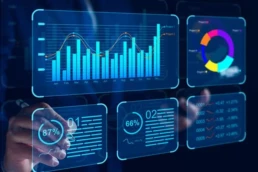Supply chain management is an essential part of all businesses and plays a vital role in success and failure of an organization in today’s connected ecosystem. A resilient supply chain can help to reduce Opex, improve financial position and boost customer experience.
While historically, corporates have invested heavily on Business Intelligence and rendering of Supply Chain prescriptive analytics over the past years, the industry is still at an early stage when it comes to prescribing actions to uncover important business drivers and gain competitive advantage. For quite a while analytics, in its ‘current-state,’ providing only the historical perspective, served quite well. But in this age of hyper-connectivity and heightened customer expectations, organizations have to look into the future, understand consumer behavior and predict the demand to be on top of the game and provide better customer experience.
Even today, most businesses rely on historical supply chain prescriptive analytics and put that in some form to create a visual dashboard that reports only about the present scenarios. This data could be about the current inventory, sales, lead time, etc. These dashboards, whether graphical or tabular, show what the current state, target, gap is, and so on in the business. However, this data lacks both predictiveness and prescriptiveness. It does not dictate any action that an organization needs to take to resolve a particular issue. It lacks the vital elements of advanced analytics, which can work by examining real-time data, predicting future situations and prescribing complex, profitable decisions on the spot.
What we need today from the data is not simply highlighting of the problems but also creating a machine learning-based algorithm which gives effective supply chain management solutions. Supply Chain Analytics can obtain the accurate and holistic picture of scenarios that impact the flow of business activities. For example, if an inventory outage is predicted at a store, the retailer, depending on the time available for a response, can evaluate available options. The actions prescribed could involve a change in the mode of transportation, re-sequencing of manufacturing, changing pricing of a product for the rest of the month or expediting a set of purchase orders.
If organizations build predictive algorithms based on the real-time data and productionize those using machine learning to generate actionable business insights, the managers on the floor can leverage them to solve their business problems. The predictive models incorporate supply chain data from external and internal sources to determine the possibility of an inability to satisfy demand at a particular time. Once an impending supply chain issue is detected, a prescriptive action can be launched to either mitigate it or solve it.
Today’s supply chain analytics is just good enough to make us situationally aware. However, advanced prescriptive analytics has to kick in to make a difference. The next-gen supply chain analytics, based on machine learning, is a great asset to design predictive models, which can identify complex situaitions in time to execute prescriptive measures and actionable insights. As a manager on the floor, what is that s/he can do to ensure that there is an action taken to address a problem? This will help the enterprise in not losing revenue or incur more cost but even save it from any embarrassing customer experience. Supply Chain Prescriptive Analytics can bring exceptional intelligence to your business, reducing overall cost to serve and improving service levels.


